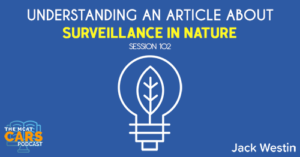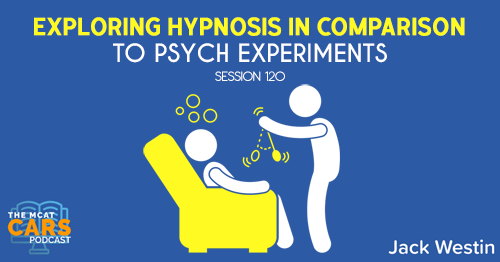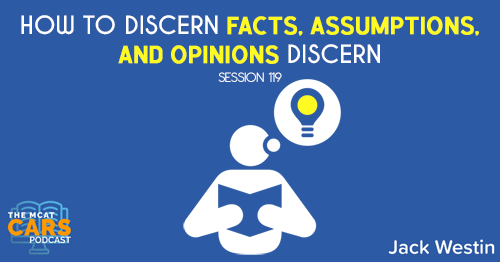Apple Podcasts | Google Podcasts
Session 102
We practice our critical reading skills with an article about surveillance in nature and rural areas. Listen as we break down the author’s perspective!
As always, I’m joined by Jack Westin from JackWestin.com. Check out all their amazing free resources including a free trial session of Jack’s full course to see how it’s like learning from Jack Westin himself.
Listen to this podcast episode with the player above, or keep reading for the highlights and takeaway points.
Link to the article:
https://reallifemag.com/camera-traps/
You’re walking along a forest trail. You’ve been walking for a while now, and your bladder is full. It’s been a long while since you’ve passed another person, but as a precaution, you take a few strides off the path before dropping your pants. When you’re done, you look up, and scan your surroundings. Your eye catches on something. It would be easy to miss: a small, rectangular box, disguised crudely in camo print, attached to a tree trunk with a strap. It blinks at you with its single eye.
We know that surveillance is ubiquitous in cities, but most of us rarely think about the fact that networks of surveillance extend even into forests and marshes, deserts and oceans. We tend to think of technological infrastructure as ending where the visible built environment does, which is not an unfounded assumption, especially in national parks and nature reserves which actively market themselves as places to “switch off.” When our phone ceases to pick up a signal, it corroborates the impression we’ve finally found ourselves in a place where technology has no power over us. The reality, however, is that often these places are thrumming with devices, some more visible than others, quietly monitoring soundscapes, air quality, humidity, temperature, soil acidity, the presence and absence of different species, of people.
Monitoring — via GIS, passive or automated sampling, video and audio recording, or biomonitoring — is a vital part of ecological research, enabling researchers to track the degradation and regeneration of ecosystems, document extreme weather events, identify rapid drops or increases in animal or plant species, and determine ecosystem health. It is tempting to think that this might constitute a form of “good” surveillance. But the militaristic, colonial history this surveillance belongs to is not simply waived by the fact that it operates in a forest. Even inadvertently, many of the tools we use to do environmental science end up reproducing these systems.
The rise of surveillance technologies in conservation science corresponds with a turn towards methods that are ‘non-invasive’, allowing research to happen at a distance from its subject, and therefore resulting in minimal disturbance. One of the most effective and therefore common monitoring devices found in nature is the camera trap, also known as a trail camera. Widely used in ecology to monitor the population size, distribution and behavior of different species of animals, camera traps are cameras that are activated by a motion or infra-red sensor, trip-wires, pull-wires, pressure plates, lasers or microwave sensors. They can be left alone, for weeks or months on end, to capture images of wildlife. Inconspicuous in appearance and housed in weatherproof casing, they enable researchers to observe rare events in a “non-invasive” manner, and without the physical and mental strain of waiting and watching.
[02:05] Paragraph 1, Sentence 1
You’re walking along a forest trail.
Jack says:
Try to visualize that you’re walking on a forest trail.
[02:26] Paragraph 1, Sentence 2
You’ve been walking for a while now, and your bladder is full.
Jack says:
Also, try to visualize that you want to urinate.
[02:39] Paragraph 1, Sentence 3
It’s been a long while since you’ve passed another person, but as a precaution, you take a few strides off the path before dropping your pants.
Jack says:
Now, you’re going to go pee in a bush somewhere.
[03:00] Paragraph 1, Sentence 4
When you’re done, you look up, and scan your surroundings.
Jack says:
You want to make sure nobody’s watching.
[03:08] Paragraph 1, Sentences 5-7
Your eye catches on something. It would be easy to miss: a small, rectangular box, disguised crudely in camo print, attached to a tree trunk with a strap. It blinks at you with its single eye.
Jack says:
So the author gave us good imagery here that you’re walking in a forest and you wanted to go pee. Then you noticed a camera strapped to a tree.
[03:54] Paragraph 2, Sentence 1
We know that surveillance is ubiquitous in cities, but most of us rarely think about the fact that networks of surveillance extend even into forests and marshes, deserts, and oceans.
Jack says:
The author here is saying that most people will understand we have cameras in cities and there’s really no privacy anywhere. But we don’t think about how, in these rural, secluded areas, we also may be surveilled.
'Make sure you visualize it the right way the way the author wants you to.'Click To Tweet[04:48] Paragraph 2, Sentence 2
We tend to think of technological infrastructure as ending where the visible built environment does, which is not an unfounded assumption, especially in national parks and nature reserves which actively market themselves as places to “switch off.”
Jack says:
The author is giving us some more ammo as to why we we don’t think we can be surveilled in these remote areas.
[05:29] Paragraph 2, Sentence 3
When our phone ceases to pick up a signal, it corroborates the impression we’ve finally found ourselves in a place where technology has no power over us.
Jack says:
It’s more of the personal bias of our phone doesn’t have a signal, therefore, there’s no technology here.
[05:49] Paragraph 2, Sentence 4
The reality, however, is that often these places are thrumming with devices, some more visible than others, quietly monitoring soundscapes, air quality, humidity, temperature, soil acidity, the presence and absence of different species, of people.
Jack says:
They’re basically saying that our assumptions are wrong. And that these places can have lots of devices doing all these different things even if there is really no signal out there.
[06:29] Paragraph 3, Sentence 1
Monitoring — via GIS, passive or automated sampling, video and audio recording, or biomonitoring — is a vital part of ecological research, enabling researchers to track the degradation and regeneration of ecosystems, document extreme weather events, identify rapid drops or increases in animal or plant species, and determine ecosystem health.
Jack says:
The author here is giving us examples of why we have all this technology out in the wilderness. The author’s not claiming that we have all this technology to surveil us. But it’s just out there. Some people might misread this, however, and assume this has something to do with our privacy. Since it’s what we see right now with social media taking over big
[07:54] Paragraph 3, Sentence 2
It is tempting to think that this might constitute a form of “good” surveillance.
Jack says:
This is another possible assumption. We’re trying to make sure our ecosystem is healthy. And so that must be “good” but the author is not necessarily reading into that either.
[08:14] Paragraph 3, Sentence 3
But the militaristic, colonial history this surveillance belongs to is not simply waived by the fact that it operates in a forest.
Jack says:
Picking up on author tone here, the author is setting up that we might think this is good. But with the word “militaristic,” the author is potentially saying it is bad colonial history. We have this surveillance belonging to this history. And it doesn’t, all of a sudden, make surveillance good just because it’s operating in a forest.
Most people would say, colonialism is bad. Maybe it’s not bad for at least the author. So we cannot bring in our judgment and transfer them to the author. It’s not acceptable. But in this case, we don’t have to transfer. The author is helping us and giving us their tone.
So you may think that colonialism is bad as it probably is, but we cannot put words into the author’s mouth. Because the author is obviously transitioning to talking about this in a negative context, now we can assume military or colonization is bad.
[10:29] Paragraph 3, Sentence 4
Even inadvertently, many of the tools we use to do environmental science end up reproducing these systems.
Jack says:
These negative military, colonial kinds of systems can’t be overlooked. At least, that’s what the author is trying to say. The author’s saying we should be skeptical. We should be worried. The author is injecting this kind of tone into the passage.
[11:54] Paragraph 4, Sentence 1
The rise of surveillance technologies in conservation science corresponds with a turn towards methods that are ‘non-invasive’, allowing research to happen at a distance from its subject, and therefore resulting in minimal disturbance.
Jack says:
The author is pointing out that these surveillance technologies allow us to not disturb things and be far away from what we’re studying.
[13:00] Paragraph 4, Sentence 2
One of the most effective and therefore common monitoring devices found in nature is the camera trap, also known as a trail camera.
Jack says:
It’s going back to coming full circle to us getting caught with our pants down.
[13:20] Paragraph 4, Sentence 3
Widely used in ecology to monitor the population size, distribution and behavior of different species of animals, camera traps are cameras that are activated by a motion or infra-red sensor, trip-wires, pull-wires, pressure plates, lasers or microwave sensors.
Jack says:
It’s defining what these camera traps are and how they work. The author is definitely pointing out that this is really sophisticated stuff. And it’s not just in the urban environment. It’s also in these forests and different natural places.
[14:47] Paragraph 4, Sentence 4
They can be left alone, for weeks or months on end, to capture images of wildlife.
Jack says:
More details on how these cameras work and how you can leave them alone, which leads to that minimal disturbance of the environment.
[15:05] Paragraph 4, Sentence 5
Inconspicuous in appearance and housed in weatherproof casing, they enable researchers to observe rare events in a “non-invasive” manner, and without the physical and mental strain of waiting and watching.
Jack says:
It’s talking about the technology specifically with these cameras and how they’re good for observing nature.
[16:38] Main Idea
It seems like an easy read, but they could test you on the more minute kind of details, not in terms of what kind of camera they’re using, or how they’re setting it up. But it’s more about tone and how the author perceives this idea, and what are the bigger ideas of the passage that you may overlook.
The main idea of this passage would be that this kind of surveillance technology exists throughout nature. And ultimately, there is potential for it to be problematic.
Even in the last paragraph, the author is quoted saying “non-invasive.” The reason why it’s quoted is that maybe it is invasive. Maybe it actually does interfere to some extent. That’s the whole point of view that peeing in the bush actually does kind of bother you. It actually does get in your way. But the bigger point is that it’s everywhere.
Links:
Link to the article:
SEARCH SITE
SEARCH SITE
LISTEN FOR FREE












